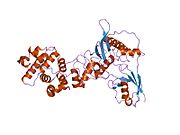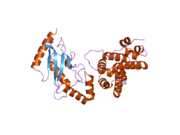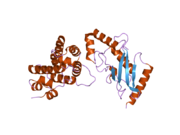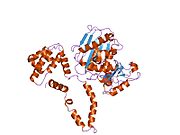Biology:RANGAP1
 Generic protein structure example |
Ran GTPase-activating protein 1 is an enzyme that in humans is encoded by the RANGAP1 gene.[1][2]
Function
RanGAP1, is a homodimeric 65-kD polypeptide that specifically induces the GTPase activity of RAN, but not of RAS by over 1,000-fold. RanGAP1 is the immediate antagonist of RCC1, a regulator molecule that keeps RAN in the active, GTP-bound state. The RANGAP1 gene encodes a 587-amino acid polypeptide. The sequence is unrelated to that of GTPase activators for other RAS-related proteins, but is 88% identical to Rangap1 (Fug1), the murine homolog of yeast Rna1p. RanGAP1 and RCC1 control RAN-dependent transport between the nucleus and cytoplasm. RanGAP1 is a key regulator of the RAN GTP/GDP cycle.[2]
Interactions
RanGAP1 is a trafficking protein which helps transport other proteins from the cytoplasm to the nucleus. Small ubiquitin-related modifier needs to be associated with it before it can be localized at the nuclear pore.[3]
RANGAP1 has been shown to interact with:
References
- ↑ "Human RanGTPase-activating protein RanGAP1 is a homologue of yeast Rna1p involved in mRNA processing and transport". Proc Natl Acad Sci U S A 92 (5): 1749–53. Apr 1995. doi:10.1073/pnas.92.5.1749. PMID 7878053. Bibcode: 1995PNAS...92.1749B.
- ↑ 2.0 2.1 "Entrez Gene: RANGAP1 Ran GTPase activating protein 1". https://www.ncbi.nlm.nih.gov/sites/entrez?Db=gene&Cmd=ShowDetailView&TermToSearch=5905.
- ↑ "Biochemistry. All in the ubiquitin family". Science 289 (5479): 563–4. 2000. doi:10.1126/science.289.5479.563. PMID 10939967.
- ↑ "The crystal structure of rna1p: a new fold for a GTPase-activating protein". Mol. Cell 3 (6): 781–91. Jun 1999. doi:10.1016/S1097-2765(01)80010-1. PMID 10394366.
- ↑ "RNA1 encodes a GTPase-activating protein specific for Gsp1p, the Ran/TC4 homologue of Saccharomyces cerevisiae". J. Biol. Chem. 270 (20): 11860–5. May 1995. doi:10.1074/jbc.270.20.11860. PMID 7744835.
- ↑ "RanGAP1 induces GTPase activity of nuclear Ras-related Ran". Proc. Natl. Acad. Sci. U.S.A. 91 (7): 2587–91. Mar 1994. doi:10.1073/pnas.91.7.2587. PMID 8146159. Bibcode: 1994PNAS...91.2587B.
- ↑ "Large-scale mapping of human protein-protein interactions by mass spectrometry". Mol. Syst. Biol. 3: 89. 2007. doi:10.1038/msb4100134. PMID 17353931.
- ↑ "Role of an N-terminal site of Ubc9 in SUMO-1, -2, and -3 binding and conjugation". Biochemistry 42 (33): 9959–69. Aug 2003. doi:10.1021/bi0345283. PMID 12924945.
- ↑ "Ubc9 sumoylation regulates SUMO target discrimination". Mol. Cell 31 (3): 371–82. Aug 2008. doi:10.1016/j.molcel.2008.05.022. PMID 18691969.
Further reading
- "RNA1 encodes a GTPase-activating protein specific for Gsp1p, the Ran/TC4 homologue of Saccharomyces cerevisiae". J. Biol. Chem. 270 (20): 11860–5. 1995. doi:10.1074/jbc.270.20.11860. PMID 7744835.
- "RanGAP1 induces GTPase activity of nuclear Ras-related Ran". Proc. Natl. Acad. Sci. U.S.A. 91 (7): 2587–91. 1994. doi:10.1073/pnas.91.7.2587. PMID 8146159. Bibcode: 1994PNAS...91.2587B.
- "Ubiquitous expression and testis-specific alternative polyadenylation of mRNA for the human Ran GTPase activator RanGAP1". Gene 180 (1–2): 7–11. 1997. doi:10.1016/S0378-1119(96)00389-7. PMID 8973340.
- "A novel ubiquitin-like modification modulates the partitioning of the Ran-GTPase-activating protein RanGAP1 between the cytosol and the nuclear pore complex". J. Cell Biol. 135 (6 Pt 1): 1457–70. 1997. doi:10.1083/jcb.135.6.1457. PMID 8978815.
- "A small ubiquitin-related polypeptide involved in targeting RanGAP1 to nuclear pore complex protein RanBP2". Cell 88 (1): 97–107. 1997. doi:10.1016/S0092-8674(00)81862-0. PMID 9019411.
- "A Novel Class of RanGTP Binding Proteins". J. Cell Biol. 138 (1): 65–80. 1997. doi:10.1083/jcb.138.1.65. PMID 9214382.
- "The Ras-RasGAP complex: structural basis for GTPase activation and its loss in oncogenic Ras mutants". Science 277 (5324): 333–8. 1998. doi:10.1126/science.277.5324.333. PMID 9219684.
- "Molecular Characterization of the SUMO-1 Modification of RanGAP1 and Its Role in Nuclear Envelope Association". J. Cell Biol. 140 (2): 259–70. 1998. doi:10.1083/jcb.140.2.259. PMID 9442102.
- "Characterization of a second member of the sentrin family of ubiquitin-like proteins". J. Biol. Chem. 273 (18): 11349–53. 1998. doi:10.1074/jbc.273.18.11349. PMID 9556629.
- "In vitro SUMO-1 modification requires two enzymatic steps, E1 and E2". Biochem. Biophys. Res. Commun. 254 (3): 693–8. 1999. doi:10.1006/bbrc.1998.9995. PMID 9920803.
- "The crystal structure of rna1p: a new fold for a GTPase-activating protein". Mol. Cell 3 (6): 781–91. 1999. doi:10.1016/S1097-2765(01)80010-1. PMID 10394366.
- "The DNA sequence of human chromosome 22". Nature 402 (6761): 489–95. 1999. doi:10.1038/990031. PMID 10591208. Bibcode: 1999Natur.402..489D.
- "Prediction of the coding sequences of unidentified human genes. XX. The complete sequences of 100 new cDNA clones from brain which code for large proteins in vitro". DNA Res. 8 (2): 85–95. 2001. doi:10.1093/dnares/8.2.85. PMID 11347906.
- "Structural basis for E2-mediated SUMO conjugation revealed by a complex between ubiquitin-conjugating enzyme Ubc9 and RanGAP1". Cell 108 (3): 345–56. 2002. doi:10.1016/S0092-8674(02)00630-X. PMID 11853669.
- "SUMO-1 targets RanGAP1 to kinetochores and mitotic spindles". J. Cell Biol. 156 (4): 595–602. 2002. doi:10.1083/jcb.200110109. PMID 11854305.
- "Enzymes of the SUMO Modification Pathway Localize to Filaments of the Nuclear Pore Complex". Mol. Cell. Biol. 22 (18): 6498–508. 2002. doi:10.1128/MCB.22.18.6498-6508.2002. PMID 12192048.
- "Large-scale characterization of HeLa cell nuclear phosphoproteins". Proc. Natl. Acad. Sci. U.S.A. 101 (33): 12130–5. 2004. doi:10.1073/pnas.0404720101. PMID 15302935. Bibcode: 2004PNAS..10112130B.
- "Structural and dynamic independence of isopeptide-linked RanGAP1 and SUMO-1". J. Biol. Chem. 279 (47): 49131–7. 2005. doi:10.1074/jbc.M408705200. PMID 15355965.










